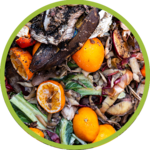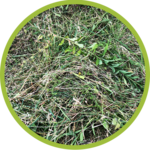Educt data sheets
The educt data sheet series provides an overview of biogas production from biowaste, cereal straw, green waste and cattle slurry. The mobilizable potential of an educt in Germany is shown and specific methane yields are presented. In addition, the feedstock data sheets contain information on the material and energy use of the respective feedstock, as well as its mobilizable technical potential. Furthermore, the status quo for biogas production of the respective feedstock in Germany is described and considered in the context of technological challenges. In addition, an exemplary composition of the feedstock is shown, as well as the legal framework conditions that must be taken into account when fermenting the respective feedstock.
Educt data sheet: Cereal straw
Straw is the main by-product of agricultural grain production and has a high untapped potential for increased material as well as energetic utilization. With the help of microorganisms, lignocellulose-rich straw can be biologically converted directly into biogas as an energy source. In addition to the wheat straw considered here, this also applies to the straw of other cereals and other crops such as rapeseed.
» Download [German Version] (PDF, 209 KB)
Educt data sheet: Cattle slurry
Cattle slurry is produced in large quantities during animal husbandry. The energy content of cattle slurry varies widely depending on the design of the barn, the manure removal process, the slurry management (storage period, use of water) and the proportion of feed residues. With the help of microorganisms, cattle manure can be converted into biogas and a fermentation product. Depending on the regional cattle density, the fermentation products can be used locally as a valuable organic fertilizer in crop cultivation or have to be exported to other regions after complex processing.
» Download [German Version] (PDF, 199 KB)
Educt data sheet: biowaste
In the context of the Pilot-SBG project, biowaste includes food and kitchen waste from private households, which is collected proportionally via the organic waste garbage can and mixed municipal waste (household waste), as well as previously uncollected quantities that are composted privately, for example. Biowaste, along with green waste and landscape maintenance waste, is thus included in biowaste as defined by the Closed Substance Cycle Waste Management Act.
» Download [German Version] (PDF, 235 KB)
Educt data sheet: Green waste
In the context of the Pilot-SBG project, green waste includes garden and park waste, proportionately from organic waste garbage cans and proportionately from mixed municipal waste (household waste), as well as garden and park waste collected separately and not previously. Alongside biowaste and landscape maintenance waste, green waste is thus bio-waste as defined by the Closed Substance Cycle Waste Management Act.
» Download [German Version] (PDF, 219 KB)







